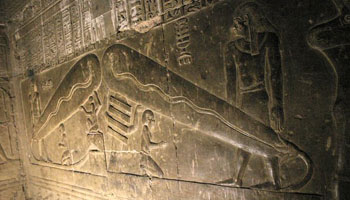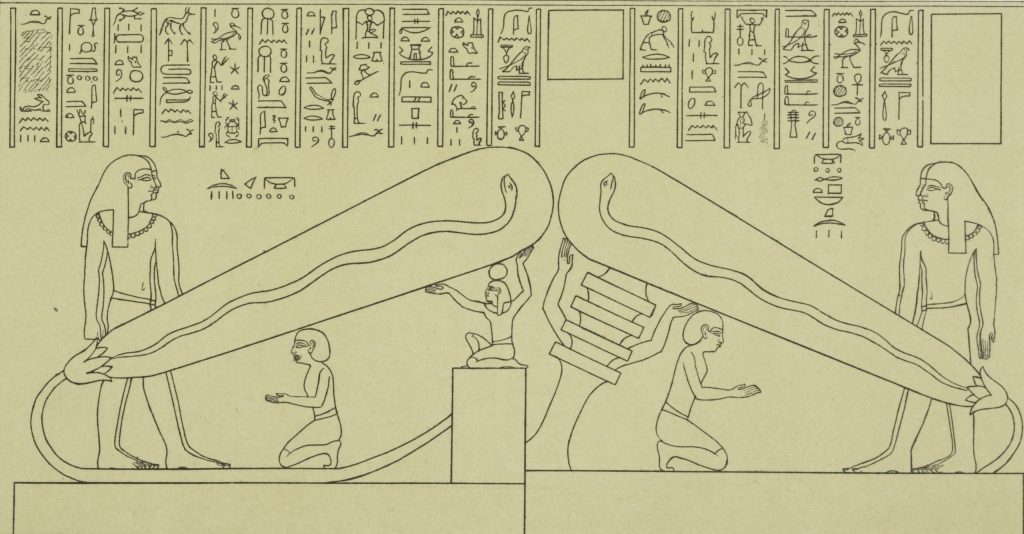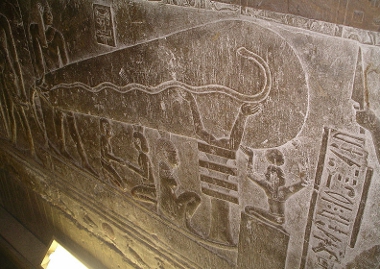Beneath the Temple of Hathor at Dendera there are inscriptions depicting a bulb-like object which some have suggested is reminiscent of a “Crookes tube” (an early lightbulb). Inside the “bulbs” a snake forms a wavy line from a lotus flower (the socket of the bulb). A “wire” leads to a small box on which the air god is kneeling. Beside the bulb stands a two-armed djed pillar, which is connected to the snake, and a baboon bearing two knives.

In “The Eyes of the Sphinx”, Erich Von Daniken suggested that the snake represented the filament, the djed pillar was an insulator, and the tube was in fact an ancient electric light bulb. The baboon was apparently a warning that the device could be dangerous if not used correctly.
The crypts are generally considered to be store-rooms, and only a few are decorated. At the southern end of the temple there are five subterranean crypts. They were thought to house the most valuable of the temple statues and objects including the “ba” of Hathor, used during ritual processions at New Year. A gold statuette of Hathor sat within a large kiosk formed by four gold posts, a gold base, and roof.

Fine linen hung from copper rails between the posts, so that the goddess remained hidden. According to the texts written on the walls, we know that the kiosk consisted of a gold base surmounted by a gold roof supported by four gold posts, covered on all four sides by linen curtains hung from copper rods. The strange inscriptions are in the easternmost of the small chambers.
The temple is constructed of sandstone, but a large block of limestone had been installed in the wall as the surface for the carving. This indicates that the architects went to some effort to allow the production of fine quality carving indicating that the scenes were of ritual or religious significance.
We do not know the exact origin of the Djed pillar, but its hieroglyphic meaning (“enduring” or “stability” and sometimes “column”) is not doubted. There is no apparent connection between the concept of “enduring” and the process of insulating, but even if there was, it is my understanding that the Djed wouldn’t work as an insulator. In a light bulb, the glass bulb itself insulates the filament, and no extra component is required.
The “cable” is described in the text beside the depiction as a symbolic sun barge moving across the sky (in a form which is by no means unique to these carvings). It seems to be a bit of a stretch to describe this as a cable, although I suppose you could argue that the movement of the sun mirrored the movement of electricity. However, the “cable” is attached to what proponents describe as a “socket”, but is in fact a lotus flower. This flower appears in this form all over Egypt, and is always a lotus flower. Furthermore, the text beside the depiction confirms that it is a lotus flower.

Sylvie Caulville worked extensively on the inscriptions in the temple. She suggested that in the carvings, Hor-sema-tawy (or Harsomptus “Horus the uniter of the two lands”) is depicted as a serpent, a falcon, and as a child (Ihy the son of Hathor and Horus of Behedet). According to one myth, Ihy sprung into existence out of a lotus flower which blossomed in the watery abyss of Nun at dawn at the beginning of every year. It is therefore suggested by some that the “light-bulbs” are in fact lotus flower bulbs, mythologically giving birth to the god. Another panel shows the bulb opening into a lotus blossom and the snake standing erect in the centre as a representation of the god Ihy. On the southern wall of the last room, a falcon, preceded by a snake emerges from a lotus blossom within a boat.

Francois Daumas suggested that the sacred procession which was held on the eve of the first day of the New Year, began in these rooms. Thus the inscriptions represented the myth which was being celebrated. Of course, the myths have nothing to say regarding light bulbs, and there is no evidence to substantiate their use from Egyptian remains or text. This is fairly damning as the building of huge stone monuments required the maintenance of detailed and thorough accounts, yet there is no record of any electric devices or the movement of raw materials to create them.
Some are still unwilling to entirely give up on the idea of the Dendera light bulb. Instead of claiming that the Egyptians used light bulbs under normal conditions, they suggest that the priests performed a ritual which created a small amount of light during the New Year celebrations. Proponents claim that the reliefs describe a three stage process; first the “bulb” is supported by a kneeling figure making three “waves” emanate from the serpent, then the “bulb” is supported by a Djed pillar making four “waves” emanate from the serpent, finally the “bulb” is placed against a vertical Djed pillar causing five “waves” to emanate from the serpent’s body. The waves are thought to be evidence of a vibratory process increasing in frequency as the scenes progress.

This is certainly a more creative theory which neatly avoids the lack of any supporting evidence by claiming that the ceremony was ritual and secret. The problem remains that all of the elements are known to have specific meanings from numerous other sources, and the text confirms those meanings. However, it is still possible that the priests encoded a deeper meaning in the text and images.
Copyright J Hill 2010